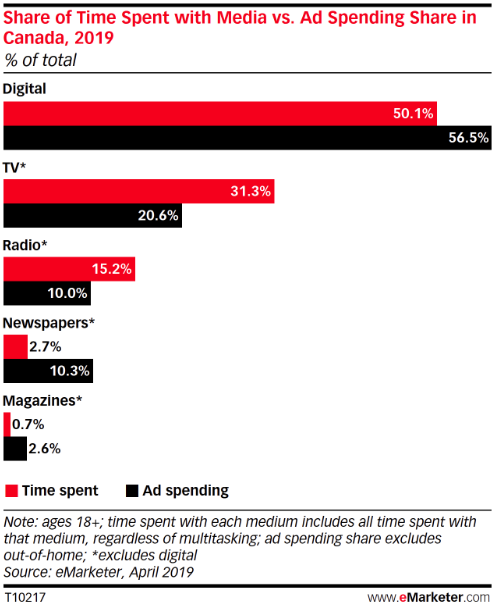Time spent with digital media in Canada has surpassed that of traditional media for the first time, and digital ad spending has finally caught up with the changing way in which Canadians are consuming media.
eMarketer estimates that consumers in Canada will spend 9 hours, 50 minutes (9:50) per day on media this year, with 4:55 of that time spent on digital and 4:54 spent on traditional.
Just two years ago, digital ad spending still lagged digital time spent, reflecting some of the ineffectiveness of early digital ad formats and a lack of marketer understanding of the medium's specific metrics. But this year, digital ad spending will make up more than half (56.5%) of total ad spend, which is 6.4 percentage points more than digital time share.
“Digital ad formats are now being embraced in Canada because they’ve matured dramatically in the past few years,” eMarketer senior analyst Paul Briggs said. “Compared with traditional formats, the granular reporting and behavior tracking of digital ads are much more specific in assessing how well an advertiser is engaging a consumer.”
In turn, this overspending in digital ads is causing an imbalance in the way ad dollars are being spent on legacy media. This year, TV ad spending will make up 20.6% of all ad spending, even though 31.3% of Canadian consumers are spending their time with TV. Radio ad spending makes up 10.0%, even though the time spent share is 15.2%.
The biggest imbalance comes from print: 12.9% of ad dollars go to print, even though consumers are spending just 3.5% of their time with the medium. This disparity can be attributed partly to the way public policy in Canada supports the print industry at a time when digital competition erodes away at the viability of traditional news media.
In November 2018, the federal government announced a CA$600 million five-year plan to fund the industry, mainly in the form of tax breaks on the employment of journalists.
“Some advertisers still value print because readers tend to be older and more affluent,” Briggs said. “But print ad spending has cratered in comparison with all other formats—it’s about half of what it was five years ago. It will continue this decline to bring it into balance with actual time spent figures.”



No comments:
Post a Comment
Note: Only a member of this blog may post a comment.